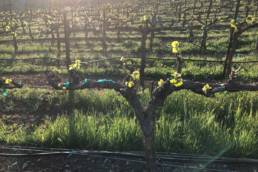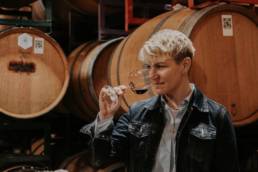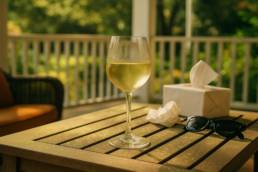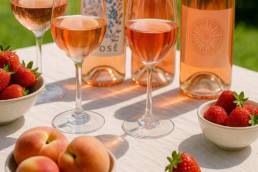FMN – July 2021 – Rose All Day
I often preach about the diminishing diversity of wine. Many wine producers change the nature of their wine to meet the “flavor of the day.” Chasing consumer fads is not necessarily a bad thing, after all, the wine business is a business. What sticks in my craw is twofold. First manipulating a wine to the point that the varietal character is lost. For example, a Pinot Noir, in my humble opinion, finds its strength in its elegance. An opaque Pinot coming in close to 16% alcohol is completely lost on me. The second infraction is when producers, reps and half-brained wine writers promote these Frankenstein wines and demonize anything different.
A microcosm of the wine industry ebbing ever closer toward a monoculture exists as the “pink” wine we call rosé. Although these wines are every bit as diverse as any other wine category, the recent market has shown a seemingly insatiable thirst for light, fruit forward pretty pink colored wine. Make no mistake, these wines are a great quaffable thirst-quencher and I’ve been known to make short work of a bottle amidst the summer heat. With the rapid increase in popularity, many producers have abandoned their style of rosé for one more easily marketable. Again, you have to sell juice to stay in business but some are made so indiscriminately, they lack any sense of place. I have no respect for wines without a soul.
To better understand this category of wine, one must understand what makes a rosé. There are many winemaking choices that affect the final product. As one would expect, what varieties you put in the wine will affect the wine’s texture, aromas and even age ability. Yes, there are rosé wines that can age for a decade or longer. Also, the amount and length of skin contact will affect the final color along with tannin perceptions and, again, ability to bottle age. These wines take longer, more attention, and more money to produce. In today’s pink flooded market, justifying a rosé above twenty-five dollars a bottle is getting more difficult.
The choice of production process varies and has an immense impact on the nature of the final wine. The first process, simply enough, is mixing a red wine and a white wine. This type of “blending” is not permitted for production of fine wines, with the notable exception of sparkling wine; including Champagne. The base wines are blended before second fermentation and there are some wines that have white and red must blended before the ferment or crushed together and co-fermented (Tavel rosé).
The second way to produce rosé is through a process called Saignée (Sahn-yay), that literally means bleeding. The grapes are harvested at optimal ripeness for red wine production and vatted for fermentation. After a short period of time (from a few hours to a few days) a small amount of the free-run juice is “bled off” from the vat and continues the ferment separately. The advantages are twofold as the original wine, destined to be a red wine, is more concentrated and the bled off portion becomes the rosé wine. The final rosé can vary greatly depending on the amount of time it spent with the original must, the environment of its continued fermentation (usually cooler temperatures) and if it sees any oak or barrel age.
These Saignée wines tend to be a bit darker in color and have a sturdier mouth feel, often with perceptible tannin structures. Although able to drink early, many of these wines will not only last in bottle but continue to develop and improve.
The direct press is another popular method for producing rosé. With this process the grapes are grown for the sole purpose of making a rosé wine. They are usually harvested a little earlier compared to the saignée, which means the must has a little lower potential alcohol, a little higher acidity and the aromatics tend to be a little more “estery” (raspberry, cherry, strawberry). The grapes are destemmed (partially or completely) and gently pressed. As the skins rupture, some color is extracted resulting in a pale must that is then fermented at lower temperatures (similar to white wine) to preserve the delicate aromatics.
There also remains the argument of white Zinfandel and their ilk. Originally created by accident at Sutter Home in California in the 1970s. Some must was bled off a fermenting tank of Zinfandel and separated for continued fermentation. For some reason, the wine failed to finish the ferment and the result was a lower alcohol wine with pronounced residual sugar. The winemakers contemplated dumping the vat and taking the loss but upon tasting, they decided it was interesting and palatable. With some creative marketing, a new brand was born.
The grapes for this style of wine are harvested earlier as there needs to be a substantial amount of acid to balance the high residual sugar in the final wine. Even with early harvest, most times an addition of tartaric acid is needed. With a short maceration time, the grapes are pressed before fermentation and the ferment arrested before finishing (by chilling, filtering off, or sulfur dioxide addition) resulting in unfermented residual sugars.
Although there have been many arguments over decades as to which process produces the best rosé wines, they all have their place. Light to dark and dry to sweet, with varying production processes and winemaking decisions, rosé is far from the same. By embracing these different styles, we ensure the survival of the diversity of rosé. Resist the marketing that one style or another is better or worse. From the sturdy deep wines you could eat with a steak to the light poolside sipper, they all deserve their time in your glass.
Rosé Suggestions:
Protocolo Rosé 2020 Vino de la Tierra de Castilla, Spain $6.99
This 50% Tempranillo and 50% Bobal wine hails from Castilla, Spain and has an interesting pale golden color with pink reflections. Although I felt the color hinted toward oxidation, the nose bursts with fresh red fruit (strawberry, cherry), salted melon and a slight hint of marshmallow “circus peanuts”. The dry palate has an interesting tart orchard fruit skin component and evident salinity. Chill slightly and serve with your charcuterie, grilled clams or ceviche.
Encostat do Lima Vinho Verde Rosé 2020 Vinho Verde DOC, Portugal $10.99
This wine has a blend of 75% Souzao, 15% Borracal and 10% Espadeiro grape varieties. One first notices the vibrant, electric pink color with a slight hint of effervescence (a hallmark of wines from this region). The nose had vibrant red fruit (raspberry, cherry), watermelon, tropical citrus and marzipan. The palate has a vibrant prickly feel from the petillance that increases the freshness with flavors of red fruit, melon rind, and a lingering brined tangerine finish. This is a fun wine that would stand on its own as an aperitif or paired with grilled seafood (shrimp, sea bass) and salty cured meats.
Bonny Doon Vineyard Vin Gris de Cigare 2020 California, Earth $14.99
A tribute to Rhone varietals but with a California twist, this wine is 71% Grenache, 11% Cinsault, 5% Clairette Blanche, 5% Grenache Blanc, 4% Mourvedre, and 4% Vermentino. The crisp reflective pink color has a beautiful vibrance. The complex aromas are overt but elegant with red fruit (cherry, strawberry, cranberry), melon, citrus (tangerine), fenugreek, and white pepper. The dry palate has a noticeable mouthfeel, attributed to the lees contact with flavors of tropical citrus (tangerine, blood orange) and an attractive sea foam finish. Pair this wine with oysters, grilled salmon with dill, buttermilk fried chicken.
Guigal Cotes du Rhone Rosé 2018 Cotes du Rhone AOC, France $15.99
This is an example of how a rosé wine can be both sturdy and elegant. The composition contains 70% Grenache, 20% Cinsault and 10% Syrah. The aromas are more subtle and slowly unveil themselves: red fruit (currant, cherry, raspberry), citrus (kumquat), and melon with a slight pleasant flowering herbal element. The palate is dry with a noticeable viscosity that balances well with the up-front tart acidity, begging for food. Pair this with everything from pork barbecue to beer can grilled chicken.




